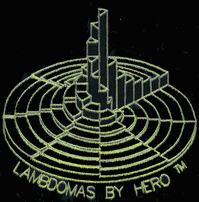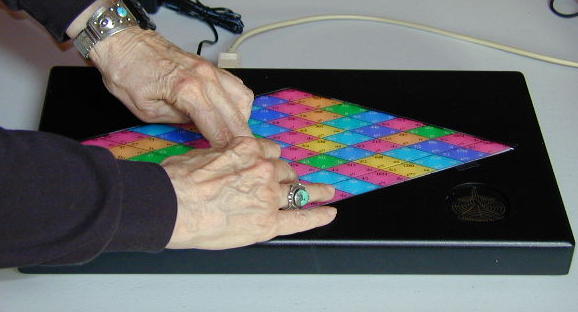About Barbara Hero
TRANSLATIONS ~ English to: 
Before her passing, Barbara Hero's son, Alfred Hero III, interviewed her about her life. This is her story, so colorful like her art and imagination! Those of us whose lives she touched have been richly blessed. May her works continue to heal, inspire, lift. ヅ
Part One ~ North Palm Drive, Beverly Hills
I was raised by my mother and grandmother. I had no brothers or sisters and seldom saw my father - a good man but given to drink and sometimes reckless behavior. We lived in Beverly Hills, which was not yet the home of moguls and movie stars when we moved there.
My grandmother had bought two adjacent vacant lots there - that part of town was an expanse of land, brush, and tarpits. My grandfather (David Evans) had died before I was born and my grandmother used the inheritance to purchase the land, intending to build a house for us and another for herself. She ended up building a big house for all three of us, and she lived with my mother and I.
The vicinity of our house was a perfect landscape for a young girl to develop as a tomboy on the wilder side. I enjoyed climbing trees, exploring tarpits, and playing with boys. I attended kindergarten at Hawthorn School, with my friend, Hugh Southerland. We would always come back to the house after classes to play in the attic and on the sunporch.
I was a difficult child, with a hot temper. This led to many conflicts with my mother. I recall a particularly violent episode when I was eight years old. A dispute had led to shouting and crying, eventually culminating with the destruction of a Chippendale chair, which I threw at my mother in a fit of unbridled anger.
Part 2 ~ Flintridge Sacred Heart Academy
I was only eight years old when I was abandoned by my mother for a year. She enrolled me as a non-Catholic intern at a Catholic convent school and moved to the East Coast.
Somewhat earlier, before I was born, she had met a fellow art student, William Jenney, at the LA Chinard School of Art. She left me behind to follow Jenney to Yale as he pursued a graduate degree in architecture. Jenney's mother taught me piano at this time. Bill Jenney was also my godfather.
As a tomboy and a non-Catholic, I was shunned by the other convent girls, who teased me about my boyish habits and tried to embarrass me by climbing into my bed at night. I was, however, embraced by the nuns as a potential convert to the Catholic faith. They consoled and nurtured me with crosses and rosaries. I still have the rosary given to me by one of the nuns. I loved the ritual and pageantry of Catholic masses, which we attended before breakfast every morning. Eating was secondary to prayer.
Part 3 ~ Back to Beverly Hills
I returned to Beverly Hills, after my mother took me out of the convent school and brought me back home. It was an abrupt change! The country was in the full depth of depression. We planted a victory garden that grew delicious fruits and vegetables for our table. These included figs and avocados, both black and green.
Beverly Hills had grown and we were surrounded by movie stars and directors - Walt Disney, George Brent and Ruth Chatterton. I was invited to Shirley Temple’s birthday party. She came to sit with me and was a friendly acquaintance through my high school years at Westlake.
Every weekend my mother and I went to movie theaters to see double features. I ate Jujube’s during the films. In one occasion, I turned around to look at the person seated behind me. He his tongue out at me - it was Mickey Rooney.
I did not have many childhood friends, but had two pet swans. The beautiful white ivory-colored birds were very dear to me. I also had pet ducks which followed me around as I walked down the street, as if I were their mother.
A traumatic memory is my witnessing a gruesome attack on my swans by a neighbor’s dog, who was one of Rin Tin Tin’s offspring. Confident in the benign nature of animals, I let the dog off the leash to let it commune with my swans. After having bitten both swans in the neck, my mother and grandmother called the police to end the ruckus. They came and shot the swans but saved the dog and gave him back to the dog’s owners.
Part 4 ~ Moving to Southern Beverly Hills
The collapse of the stock market forced my mother and grandmother to leave the Beverly Hills house where I grew up, renting it out for income. My mother had also invested in several area apartments for income. We moved to a lower income housing complex on the other side of town. My mother and I lived in an apartment with my dog Mitzi.
My grandmother lived in her own apartment. She had kept scientific books which had been my grandfather’s. We would go visit my grandmother every week. My mother and grandmother would have sherry and I would read the books on my grandfather’s science books.
I attended the public school there for only a week - which I could not stand. My mother then enrolled me in the same school she had attended as a child - Westlake School for Girls.
My mother had another boyfriend, named Sidney Graves. They had met when she was 15 and Graves was at West Point. They had kept in touch with each other over the years. I was twelve when my mother sold the Beverly Hills house and moved to Alexandria, VA .
This was during the Depression, and she needed special permission to drive across the country due to restrictions. Due to limited hotel rooms, we had to take unusual accommodations, including sleeping in cots in the Ladies Room.
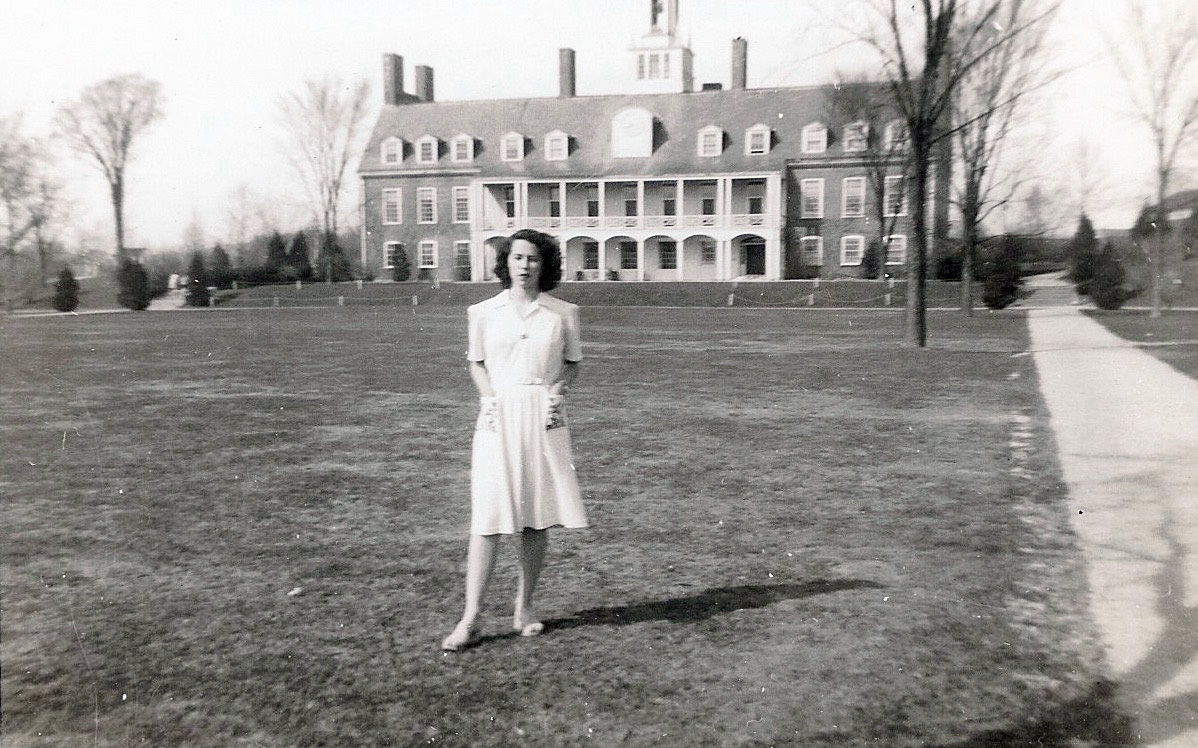
Barbara Ferrell (Hero) at Westlake School for Girls
Part 5 ~ Westlake School for Girls - Belair CA
At Westlake School for Girls, I enjoyed archery, tennis because they satisfied my boyish instincts. But I also loved literature and drama - writing poetry and reciting it to appreciative audiences. I was a member of the school’s theater troupe, playing minor roles. I was cast as the father in Little Women, but miscast as I was much smaller than the person who played the mother.
My least favorite class was history, which was often the first class of the day and I was always late due to my mother’s penchant for tardiness. At the start of my high school experience, I discovered the joy of mathematics, which I kept up with for all four years.
I spent every afternoon with the math teacher, Miss Vanberg, who allowed me to do my math homework in her office. My mother bought a book on Einstein. I took a Latin class and read Virgil’s book on Dido and Aeneas. It inspired me to write a poem that was published in a literary journal.
My first date was in senior year, a blind data who was much more interested in my roommate at first. A man from New Hampshire, Alexander MaClaurin. He, was an air force pilot on leave from his base in San Diego. The relationship lasted several years.
He always carried guns and buzzed our house with airplane to express his fondness for me. He spent several days at my house with me and my mother - and thought that my mother was trying to poison him.
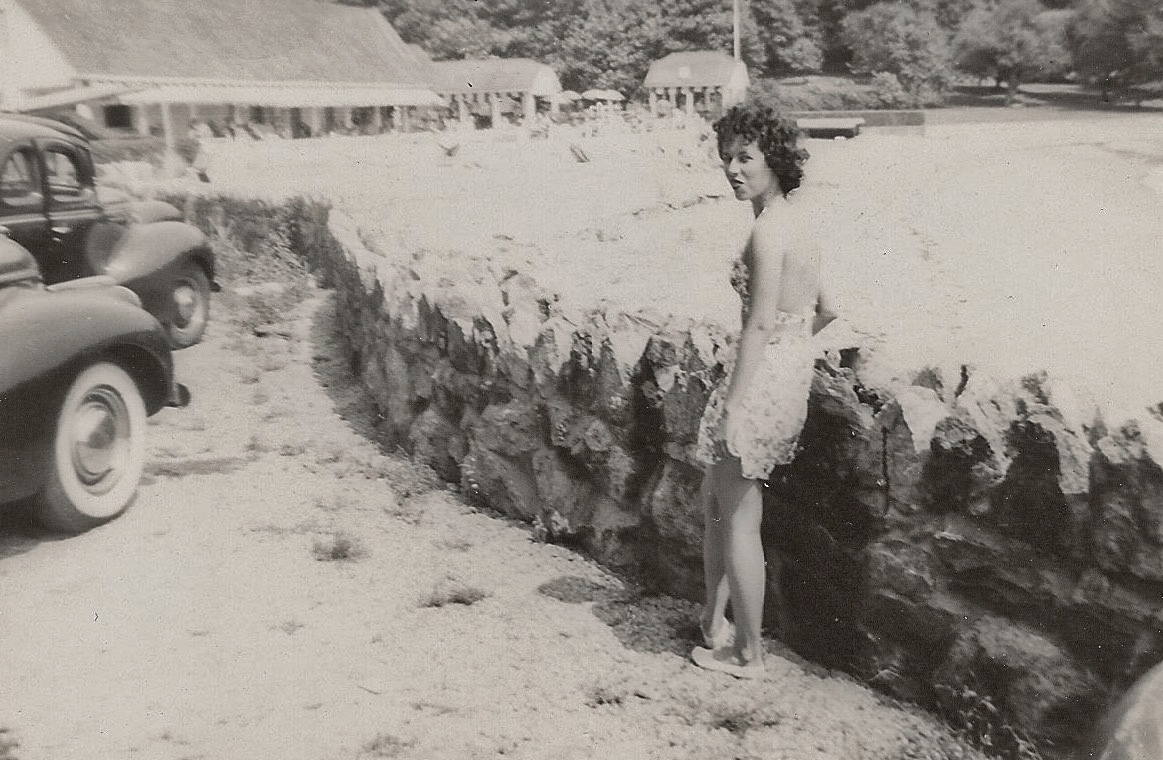
Barbara in Los Angeles. Click for image only.
Part 6 ~ Bennington
I took classes in art, architecture, literature and mathematics. However, despite my high school love for math, I dropped out of the mathematics curriculum due to the terrible math teacher.
I had two friends, one a dancer from Bronx and the other a school teacher’s daughter from Washington DC. The three of us were all considered odd and lived as happy outcasts.
I continued to see my boyfriend Alexander who was attending Dartmouth. During the winter break I stayed with my mother at a fine hotel in NYC where she was trying to develop her artist career. She had several art shows in New York City at that time, including one at the Bonisteel Gallery. She befriended many artists there including Emily Post.
My relationship with Alexander continued during this time. We were to meet at Grand Central Station, but when my mother found out she became angry, joining me at Grand Central, and blocking me from taking the elevator to meet him with her capacious body. I never saw him again, and found out that he was seriously injured a few months later during the War.
In my last year. I took a class in architecture and the class project was to visualize a new village of Bennington in drawing. I drew circles of rows of trees, grass, canals, bridges and moats in concentric rings - resembling the urban landscape of a town of ancient Greece. It was very unconventional but had a professional quality. A fellow Westlake schoolmate Nancy Ahern had been expelled from Bennington for plagiarism the year before, and they suspected I had committed the same. My mother told me that I was “either a genius or a fool.”
In my second year I did an internship at Garfinkels Department Store in Washington DC, sponsored by the same organization that had sponsored Jackie Kennedy.
Part 7 ~ Washington DC and Georgetown
At Garfinkels Department Store I started in the greeting card department. I was not fast with making change for the customer’s purchases, so they changed me to the glove department. Then they moved me upstairs to the hat department, and then to women’s suit department. I had to take the garments from the back rooms to display to the customers. Recognizing my interest in these more creative arts, I was then put in charge of the French Boutique to arrange colorful scarves in display … a patron purchased a $300 umbrella from my department.
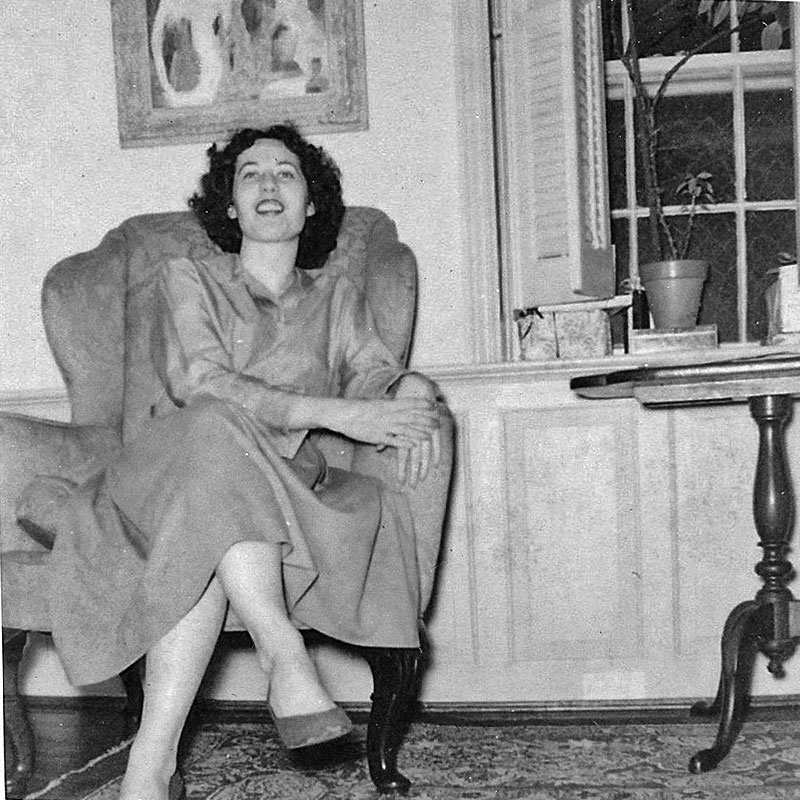
Barbara Ferrell (Hero) in Georgetown. Click for image only.
At that point I had started painting in a shared studio with my mother in our small apartment in Washington. Encouraged by my mother, I had enrolled in George Washington University, majoring in Commercial Art. There I took classes in draftsmanship and drawing. My real interest was in the fine arts but the discipline of commercial art grounded my technique, drawing shoes and other items.
Before finishing at George Washington, I taught commercial art at a girls’ school. My first art show was with my mother at the Corcoran Gallery. My mother and I were members of the Washington Workshop, run by the art dealer Franz Bader, that held poetry readings, art exhibits, and talks. We also exhibited at the Franz Bader Gallery in addition to the Phillips Gallery.
The entire organization was labeled as communist during Senator Joseph McCarthy’s inquisition in the mid-1950s. My mother and I were thus put on the “list” of communist sympathizers.
My mother and I met a patron of the arts, John Grenand, at the Phillips Gallery where she would go with me once a week. He was a docent at the Gallery and helped Mr. Phillips run the gallery. Both my mother and I had a crush on him - he was very handsome and knowledgeable about art and art history.
This platonic relationship lasted for many years. It was during this period that I met Whitney Barnes who was an assistant pastor at Saint Johns Church in Washington. We met at the Canterbury Club. He loved literature and horseback riding, and frequently wore his jompers when he came to take me out. He was very dramatic. We dated for several months.
During this time, I also met Alfred Hero, a southerner from New Orleans. My mother had met Alfred’s mother Effel, who was a friend of Helen Atkins. Helen Atkins knew my mother and purchased one of my mother’s paintings (a woman with an ox painted in a Mexican style).
My mother and Alfred’s mother met at a dinner party in a hotel. They met a man with surname Ewell, who was researching his family history. It turned out that he was a relative of Barbara Ann Ewel,l who was one of the daughters of my great grandfather, David Evans, a Mormon Bishop in Utah.
My mother was intrigued by Effel’s description of her son Alfred, whose ancestor General Pierre Gustave Toutant Beauregard, the Confederate general who ordered the first engagement of the Civil War at Fort Sumter. Alfred had a been a cadet at USMA. My mother had fallen in love with a cadet when she was younger.
This chance encounter between my mother and Alfred’s mother was the spark that led to Alfred and I meeting for the first time. My mother invited Alfred and his mother to a dinner that also included Whitney Barnes and me. The dinner was at our house in Georgetown and Whitney Barnes was paying much more attention to me than Alfred was.
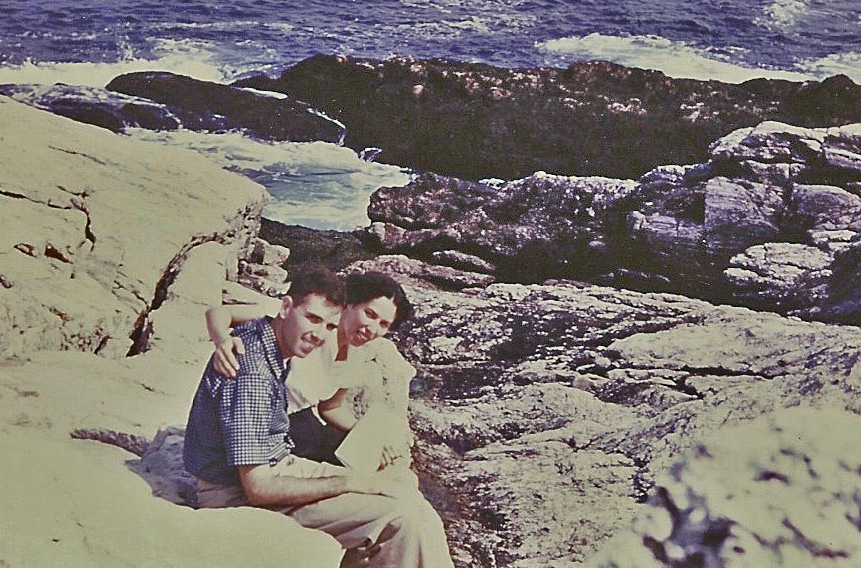
Barbara and Alfred Hero, Jr., on their honeymoon. Click for image only.
Afterwards my mother and I went to Europe, visiting England, France and Italy and crossing the Atlantic on the “Ile de France” ship. After we came back, Alfred and I started dating, seeing each other every week. On Mother’s Day of that year, he sent me a red rose and proposed. We were married several months later.
When we met Alfred was a Captain in the US Army, from the West Point Graduate class of 1945. He had rotated out from a post in Berlin, Germany, to a position at the Pentagon. His boss at the Pentagon was one of the few African American’s in upper-level positions in the US Officer Corps. Alfred never was able to reveal this fact to his mother Effel.
Part 8 ~ Cambridge Massachusetts
Alfred resigned his commission from the US Army and intended go into the State Department. He had taken the exam but a job came up at the World Peace Foundation on Beacon Hill in Boston, which he decided to take instead. We moved to Boston the same year that we were married.
Our apartment was on Brimmer Street in Back Bay, which had a wonderful view of the Charles River. We had friendly neighbors, including two young women who loaned me a ski suit to go skiing with Alfred. The suit was irreparably damaged by the rope tow at the ski resort. It was so hard to admit the damage to the generous young women, that I never wanted to ski again.
We then moved to the other side of Beacon Hill, to a larger apartment, until my first son, Alfred III, was born. The apartment was in back of the State House in an unsavory area with criminals hanging the doorstep and smoke pollution wafting through the nursery window. It was difficult to find help at this location. and we ended up hiring a former prison inmate and an alcoholic to help care for Alfred III.
We soon moved to Raymond Street in Cambridge. There I met Polly and Cliff Moler who lived nearby. Polly was a close friend for many years.
I had my second child, Barbara Ann (BAH) while still living on Raymond Street. Before I went to the hospital for BAH’s delivery, we were all exposed to chicken pox from the Moler’s family. This had the silver lining that BAH was placed in the hospital room with me after her birth instead of being put in the nursery with the other babies. Alfred was forced to wear a white mask and white robe when he visited me and BAH in the hospital. I bonded with BAH through locking our eyes together in our hospital bed during the three or four days I was in the maternity ward.
Part 9 ~ Larch Road, Cambridge
Soon after, we moved to Larch Road, on the other side of Cambridge, into a big three-story house on Fresh Pond Parkway. There, I had my two other children, Michelle and David, who were easily accommodated in the large three-story house. During this time live-in help was hired to take the role of laundresses, caretakers, cooks, and dry nurses, as I was not able to perform housewife duties during my pregnancies and miscarriages.
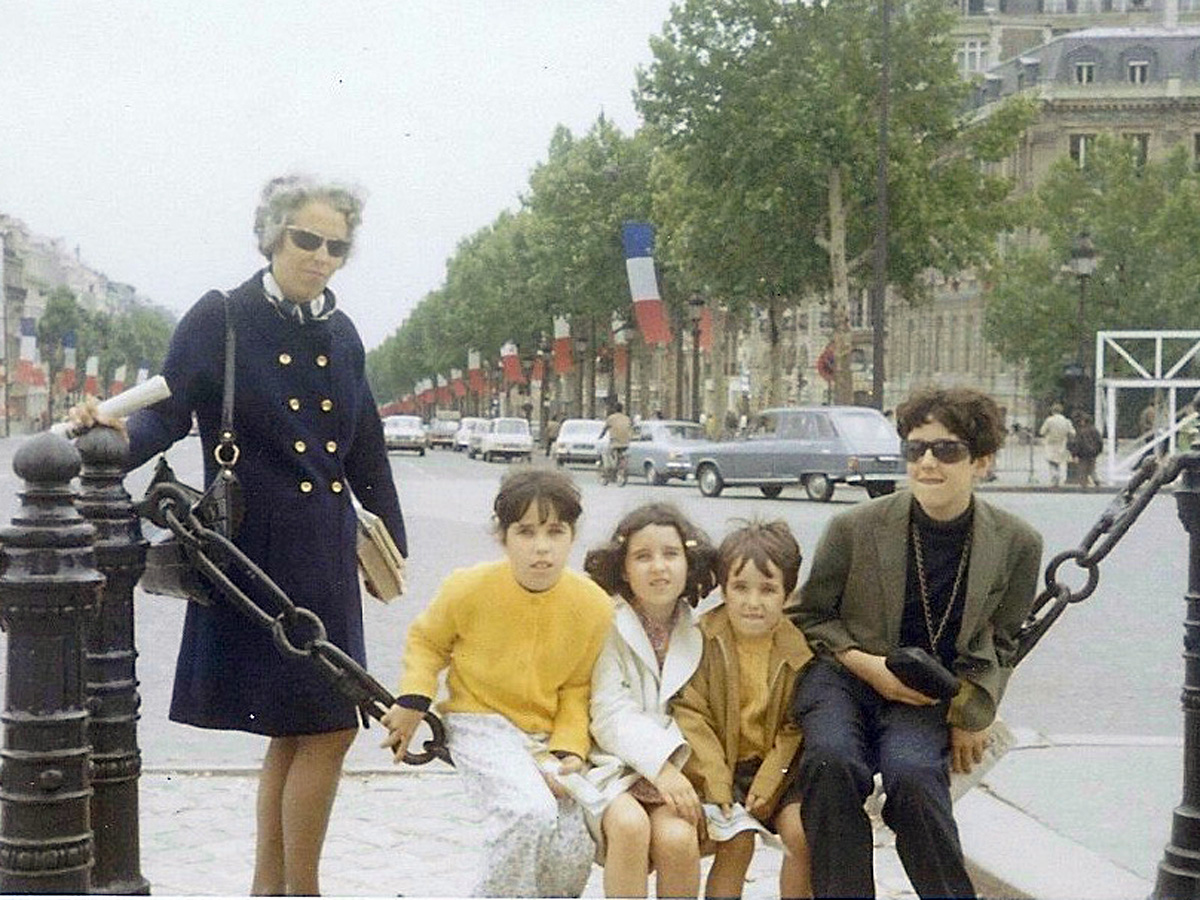
Barbara in Paris with her four children. Click for image only.
One of the people who was employed, when my daughter BAH was only 10 months old, was a Romanian women whose son was an artist. This inspired me to start doing art again. I started by building a coffee table with Italian tiles and used my son’s toy hammer. My husband, Alfred, tried to carry the table to the other side of the room and dropped it by mistake, scattering all of the colored tiles on the floor. I had to restart the table from scratch, finishing it with strong cement. This table survived all of these years and is now next to my night table.
Not deterred by this experience, soon after I started painting on the third floor of Larch Rd producing White River, Back Bay, Music Graph, and other series.
It was in 1961 that I started the White River Series, paintings that were inspired by the Charles River and its bridges. This series was successful. Four of these paintings were given to our family pediatrician, Dr. T. Berry Brazelton, in lieu of payment of his fees. The White River Series included both canvas painting and three-dimensional multimedia paintings, including a piece composed of painted wooden rods hung in front of a reflective curved mirror.
I had become interested in plastic arts and wanted to cast the White River series in a kinetic form. I had the good fortune that the husband of our helper, Mr. MacArthur, was a master carpenter. He was interested in helping me with the woodwork and made the encasement for the mirror. This was the first of a series of 3 dimensional paintings composed of intricately painted rods placed in front of convex mirrors. After the White River Series, I moved on to the Back Bay series, then onto the Music Graph series, and the Space Odyssey series, which was inspired by Stanley Kubrick’s 1968 film entitled “2001.”
Part 10 ~ Bromfield Street and Lawrence Street in Boston

Jim Martindale and Barbara Hero shared an art studio space.Click for image only.
As my artwork developed, I needed larger studio space; so I shared a studio with another artist, Jim Martindale, on the second floor of a building on Bromfield Street in Boston.
On another floor artist, Paul Lafoley had his studio. My friend Renee Arb put together an art show with me, Jim, Paul and several other men. I was the only woman in the show. Renee had discovered De Konig when she was younger and was an art historian at UMass Boston. I don’t think that the art show she put together with us had much success - it was not even reviewed. But it might have played a role in the success of Paul's work. He became quite well-known in the art world after that show.
I moved to an apartment on Lawrence Street, shortly after separating from Alfred Jr in 1970 and remained there until 1985. The apartment was on adjacent floors to the apartments of Jim Martindale and his friend, Farrel Furgeson.
I started on several new art series, evolving my art in different directions, sharing studio space with Jim in our apartment building. One series called Eyes, Ears, and Ideas combined art, geometry, music and astronomy. During that time Alfred Jr had hired an au pair, Claude de Boissieu, at Larch Road, who took great interest in this series. Her parents were astronomers, and she thought they would be inspired by these geometric works.
During this time, I met Robert Foulkrod in Boston. I met him in a class on esoteric mysticism in which I was enrolled with my close friend, Yvonne, who was a neighbor on Lawrence Street. The instructor invited Robert and me to dinner with her, and it was there that we realized we had much in common.
Robert had three children and had recently divorced in similar circumstances as I had divorced a few years earlier. Together Robert and I envisioned establishing a Light Center where we could provide a place for people to discover themselves and make progress towards enlightenment on their own terms.
After Robert’s mother died, we bought an old ambulance and drove across the country. We first went to Atlanta to attend a conference on Psychotronics, where I presented a paper. That is where I met Dan Shaw, who later became my webmaster. We then went to a Coptic Fellowship meeting in Albion, Michigan, where I started on the path to become a Coptic Minister.
Next we went to LA to give a workshop on the Lambdoma where I met Irv WIlson, who was already familiar with it. We stayed at my cousin Bill Wiley’s house in Huntington Beach, CA. I had not seen Bill for years. He was an engineer who was involved in the Apollo Space program and he was a kindred soul. He combined his interest in science and engineering with music as a performing tenor singer in a barbershop quartet. We had much in common to talk about.
When we returned from LA, Robert and I went to Hawaii to attend another Psychotronics workshop. I brought a three-sided Tetraharp that was custom constructed for me by a luthier. It was tuned to Lamboma sequences based on three different root notes and I demonstrated this to the audience.
Three volunteers were summoned to pluck the three sides of the harp in coordination, making music activated by emotion. Later the luthier wanted to buy back the Tetraharp from me, possibly to destroy it since he was terrified of a copy of the instrument he had created - losing sleep over nightmares about what he thought of the diabolical instrument.
After joining the Coptic ministry, I went to Egypt three times. On the first trip, I met Don Beaman, a Professor of Theater at BU, who was also an Egyptologist. On the third trip Don met Sarah Benson, who was a flautist and musician, and they became lifelong partners. I also met Dawn Ferguson in Egypt.
On these visits we visited Obelelisk’s and Pyramids. We visited three pyramids in Luxor, and the Great Pyramid had the most effect on me. On the first visit, I went inside the pyramid and I felt a presence as I went upstairs to the King’s and Queen’s Chambers. The Queen’s Chamber was closed on subsequent visits, so this was the only time I was able experience both of them.
On one of these visits, a member of the party laid himself down in the crypt like a madman. I had recorded an ascending Lamboma scale on a tape recorder and played it in the King’s Chamber. The resonance of the music in concordance with the dimensions of the Chamber gave me and others in my party a good feeling.
I left the party to go crawl down alone to the base of the pyramid - which was full of stone blocks and smelled of urine. When I went back all I could see was a light in the distance, which I followed until I realized that it was not getting any closer. The light was due to sunrays at the top of the pyramid which would not have been a viable exit. Luckily, I heard voices in the dark that led me to turn to a corridor, revealing the rest of the party. I found the exit with them.
On my third and last trip to Egypt, I accompanied Don and Sarah on a ship down the Nile River. We stopped at all the sacred spaces on the Nile and I played my violin while Sarah played her flute to add to the energy of these spaces. Don Beaman would talk about the Garden of Eden in Ur, the place where four rivers flowed from a common source, but this is one place we never had a chance to visit.
Part 11 ~ Wells Maine
Upon returning to Boston 1984, Robert and I endeavored to establish a Light Center in Maine. We found a 19th century farmhouse with a barn and shed on 40 acres in Wells that was a perfect location. It was an expansive property with open fields, a stream with ducks and geese, a pine grove and an expansive old growth forested area. Using the proceeds of the sale of the Lawrence Street apartments, and a loan from my mother Lucille, we purchased the property and moved there in early 1985. That summer there was a ceremony to open the Light Center, which occurred around a rune ring we laid in the field on a node of the energy grid. The ceremony was led by Don Beaman and many people attended, including my son Alfred III.
At the farm we had several permanent residents in addition to Robert and me, including Ernie and Frank. Ernie was a master carpenter and keyboard musician. He built extensive habitable spaces in the barn. Frank lived in the shed for many years. Alisa lived in the barn too for some time. but was asked to leave after she became suicidal, radiating negative energies.
Richard Norley moved in several years later. Richard was a former private investigator who brought his expansive collection of hundreds of books to the farm. He served as my second webmaster and created many of the early elements of the Lambdoma website. He digitized the Eyes plus Ears and Ideas book and this was the first presence of my work on the Internet. Many other shorter-term visitors came over the years, requiring expansion of the living spaces on the farm - in particular a trailer turned cottage that purchased from a country doctor who used it as his office. The short-term visitors included visionaries Don Beaman, Sarah Ferguson, Steven Proskauer, Steven Camp, and many others.
In the 1980’s I was invited to the sprawling estate of Peter Guy Manners in England. Peter had been promoting his Symatic Recorder, an ultrasound device for stimulating different organs in the body to prevent and treat different bodily ailments. It also recorded the response of the sonic transducers which reflected the health state of particular organs.
I purchased one of these Symatic Recorder’s and brought it back to the US. When I went through customs at the US border I was asked by the customs officer about the purpose of this strange device, and I responded that it was a musical instrument. This was a good response since the device was banned in the US as it was being promoted by Peter Guy Manners and his US followers as an unapproved medical treatment.
I showed it to my friend Jonathon Goldman, who knew and respected Peter Guy Manners’ work. He was so interested in the device that I gave it to him to experiment with. However, the device stopped working and Jonathon sent it back to England for repairs. However, when it was returned to Jonathon all the wires were cut - presumably done by the US Customs to permanently disable the device.

Barbara and Robert Foulkrod celebrate the holidays with family at Strawberry Hill Farm in Wells, MaineClick for image only.
In the mid 2000’s I started to participate in politics. I belonged to the Democratic party in Maine and wanted to play a more active role. I participated in discussions at the Democratic Convention that occurred periodically in the state capital in Augusta. I joined the Democratic Party’s Rules Committee and later the Platform Committee. While on the Platform Committee I proposed and promoted the idea of establishing a Department of Peace for the State of Maine.
As far as I know there was only one other state, Nebraska, where a similar proposal was made. The Department would consist of two Congress people, one from each party, in addition to non-political members of the departments. After much discussion my proposal for a Maine Peace Department failed to gather support in the committee.
I met Senator Dennis Kucinich during this time. One of his friends had attended a conference in Ohio where I presented the Lamboma and my perspectives on the relationship between sound and light. When Dennis found out about my work, he contacted me and I invited him to Wells Farm Light Center. He subsequently asked me to become campaign manager in Maine and New Hampshire for his campaign for US President. I declined since I did not want it to interfere with my work on the Lambdoma. Nonetheless, when he announced his intent to run for President, he invited Robert and I to his house in Ohio for the announcement.
When I entered his house, I was impressed by the creche he had in his cloakroom and I said “What a beautiful creche.” He and his wife ended up packing up the creche the next day and gave it to me to take it back to Maine. Months later, when he was campaigning in Maine for nomination to the Democratic ticket, I attended a campaign speech. After his speech Robert pulled me towards Dennis and he immediately recognized me, warmly and loudly exclaiming “Barbara!”
Part 12 ~ Topsham, Maine
When Robert died in 2008, I moved out of the farm and moved to a half-house in a retirement community in Topsham Maine. My daughter, Michelle, helped me with my move from the Farm, managed its sale, and helped me while I was in Topsham. The community also had an apartment building where I met many friends. They served breakfast at this facility and I often went to have coffee and meet people.
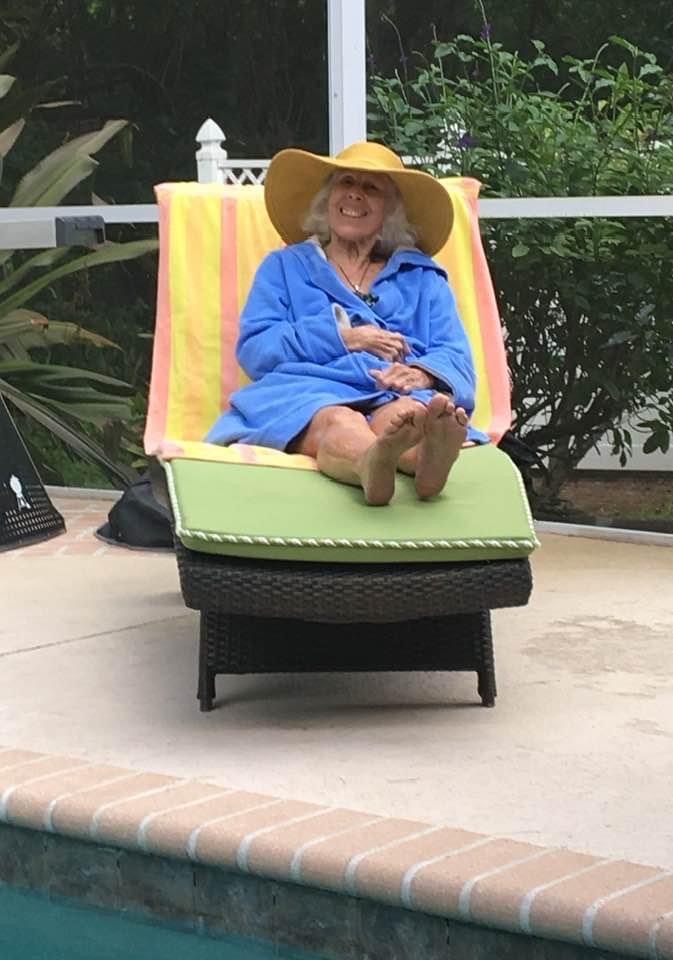
Barbara loved swimming in the pool at BAH's home. Click for image only.
Part 13 ~ Bradenton, FL
Two years later, my health deteriorated, which made it difficult to continue living independently. In 2011, I moved to Bradenton, Florida,, to be with my daughter BAH and her husband. I continued to go to conferences and meetings until 2016, presenting on the Lambdoma's role in art, music, and mathematics.
Postscript
What a life; what a woman! Barbara Hero passed on August 9, 2021, at age 96.
